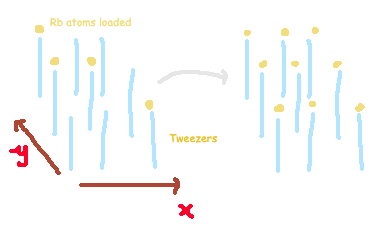Exploring Programmable Atoms: Insights into Quantum Matter
Written on
Chapter 1: Understanding Quantum Matter
At the microscopic level, nature adheres to the principles of quantum mechanics. Researchers aim to deepen their understanding of the quantum states of matter, which are intriguing configurations where atoms exhibit strong correlations. One promising method to explore these states is through computational simulations. However, accurately modeling these quantum properties using classical computers poses significant challenges, including slow processing speeds, complexity, and inaccuracy due to the entangled nature of quantum matter.
Consequently, the quest for creating programmable systems that mirror quantum mechanics is essential. Such systems would allow us to replicate the behaviors of the matter we wish to study. A significant question arises: Can we design an array of atoms that operate under quantum principles and observe their behaviors? Various techniques, including trapped ions and superconducting qubits, have been explored.
Section 1.1: The Role of Neutral Atoms
Neutral atoms, which carry no electrical charge, can exhibit fascinating behavior when cooled and arranged in a lattice structure. This arrangement permits them to act like entangled qubits, enabling researchers to investigate the characteristics of quantum matter. In [1], laser tweezers have been utilized to organize up to 256 neutral atoms, allowing for the tuning of interactions between them.

In this study, a spatial light modulator constructs a lattice of laser tweezers that holds multiple Rubidium atoms in a square grid. These particles are initially loaded uniformly into the lattice, which is then rearranged into diverse patterns using a secondary set of tweezers. Two primary quantum states are present: the ground state and the excited Rydberg state, which can be coupled via two laser beams through a two-photon transition.
Section 1.2: The Rydberg State Explained
The Rydberg formula calculates the wavelength of light emitted from an excited electron in a hydrogen atom. A Rydberg state occurs when an electron is energized to the point where its behavior closely resembles that of hydrogen, adhering to the Rydberg formula. This phenomenon typically manifests when a neutral atom receives sufficient energy for excitation.
The Dynamics
The Hamiltonian governing this system encompasses energy contributions from the lasers and interactions among the atoms in Rydberg states. The first term represents the energy from the lasers exciting the atoms, while the last term accounts for interactions between the excited states.

These atoms can be manipulated into various states, evolving according to the Hamiltonian's rules. To determine the states of the atoms, fluorescence imaging is employed, allowing for precise control over each atom. The Hamiltonian features a blockade mechanism that prevents nearby atoms from being excited simultaneously.
Creating the Checkerboard Phase
If the blockade mechanism is sufficiently strong, it becomes possible to create intriguing patterns involving both the ground and Rydberg states. By gradually adjusting the atoms' interactions, we can establish an ordered phase within a quantum many-body system. This checkerboard phase is particularly captivating as it represents an equilibrium state, albeit with broken symmetry due to the existence of two distinct checkerboard configurations.
References
[1] Sepehr Ebadi et al. Quantum Phases of Matter on a 256-Atom Programmable Quantum Simulator, arXiv:2012.12281 [quant-ph]
The first video titled "Create Anything You Want With Programmable Matter" discusses the innovative ways programmable matter can reshape our understanding of quantum systems.
The second video, "Programmable Quantum Matter," elaborates on the principles and applications of programmable matter in quantum physics.